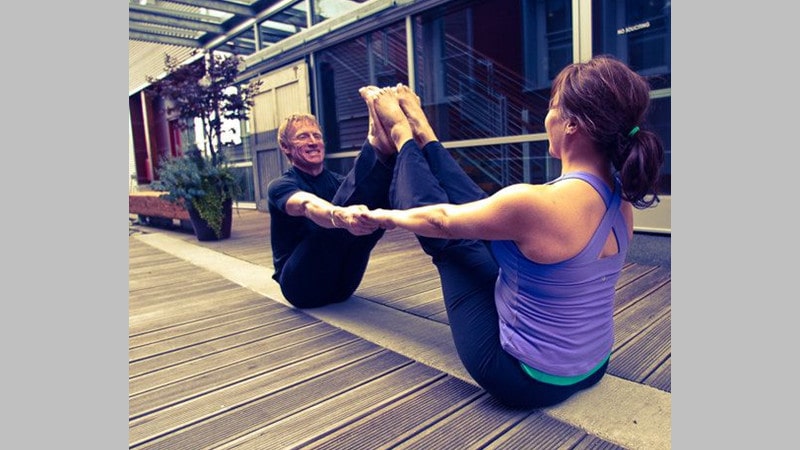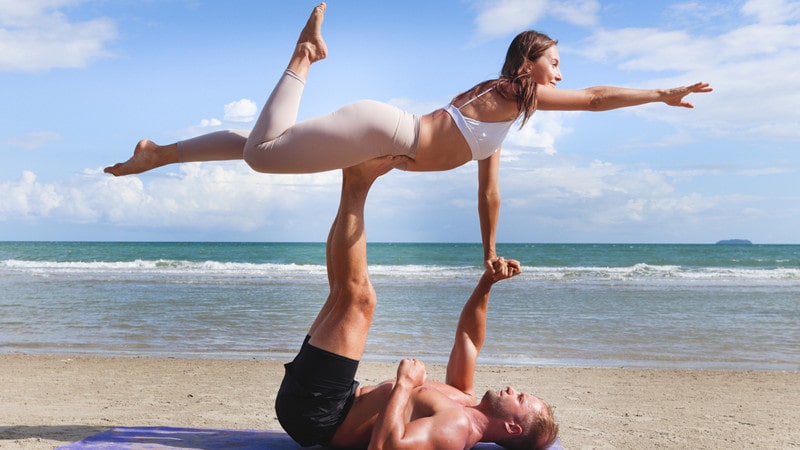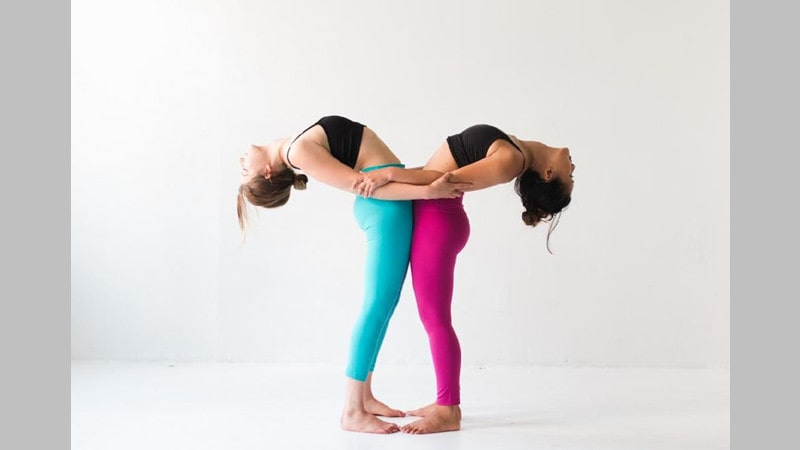Let’s be honest — yoga is a fantastic form of exercise! Not only does it help lengthen and stretch your muscles, but it also allows you to de-stress and relax, which helps you find your inner calm. However, while a solo yoga session can be fun and relaxing, you can always add some variety by grabbing a friend. In fact, partner yoga is a great way to improve communication, build trust, and, most importantly, have fun.
Sounds interesting? Then let’s check out some easy two-person yoga poses that you can try with your partner right now!
1. Partner Standing Forward Fold

Image source: Pinterest
If you are having trouble mastering the standing forward fold by yourself, you can always bring a friend to help you out. Why? Because that way, you can focus on deepening your fold without worrying about falling, since your partner is holding you and providing enough support.
Here’s how it works:
• Start in an upright position, facing the opposite direction than that of your partner with your heels at least 6 inches apart.
• Then, bend forward while trying to reach your hands at the rear of your legs until you are able to grab your partner’s shins.
• Keep bending and trying to move your hand on your partner’s shoulder.
• Once you are able to face your partner, you can relax and allow your partner to hold you and prevent you from falling.
2. Double Boat

Image source: Pinterest
The double boat position is one of the easiest you can try with a partner. As a matter of fact, it doesn’t require too much strength as, by relying on a partner, you won’t add any pressure to your hip flexors.
Intrigued? Then let’s give it a shot:
• Begin by looking towards your partner with both of your feet lying flat on the mat, your knees bent and your partner’s toes touching yours.
• Continue by holding your partner’s hands.
• Then, lean back while you lift one of your feet off the mat. It’s important to remember that you should still hold your partner’s hands and press the soles of your feet onto theirs for support.
• Once you feel comfortable, raise the other foot off the mat and continue to press the sole of your second foot into your partner’s sole.
• Keep raising your legs in sync with your partner while trying to straighten your spine.
3. Double Tree

Image source: Pinterest
When it comes to fun and exciting two-person yoga positions, you can never go wrong with the double tree. This position can help you improve your balance and learn how to distribute your weight evenly. Not only that, but it also improves communication and trust between partners. As a result, the double tree is one of the most popular positions out there, especially for couples.
To perform the double tree, you need to:
• Start by standing next to your partner, roughly one foot apart, with your hips side by side.
• Press your palms together and raise your arms upwards.
• At this point, your outer hands should be in front of you. Now, try to press your outside hand into your partner’s exterior hand.
• Make sure you put enough force into your palms so that neither you nor your partner leans further than the other.
• Once your hand is secured, you should lift your outer foot so that your sole touches your inner foot.
• Remember to use your second hand for support by grabbing your partner’s hip.
4. Flying Warrior

At first glance, the flying warrior could seem like an impossible position, especially for yoga newcomers. However, once you get the hang of it, this position will become your favorite as it helps increase trust between you and your partner.
In order to master the flying warrior, you should:
• First, decide who is the flyer and who is the support.
• The support partner starts by laying on their back with their legs slightly raised towards the sky and their knees bent.
• The second partner needs to stand in front of the support, clasping hands and trying to line their pelvis with the soles of the first partner.
• As the second partner, lean forward so that the soles of your partner’s feet support your hips.
• Then, the first partner should use their feet to raise and hold the flyer.
• Please note that the flyer needs to maintain a proper balance to prevent them from falling.
5. Chair and Mountain

Image source: Pinterest
The chair and mountain positions require both partners to put all their strength into holding and supporting each other. Therefore, it promotes communication and allows you to improve trust in your partner. This position also increases the disposition of the non-physical body, reducing stress and anxiety.
Here’s how you should practice the chair and mountain position safely:
• The first partner should start in the chair position, while the other partner needs to place one foot on their thigh, just above the knee.
• Then, both partners should lean away from each other, with the second partner placing their other foot on top of the thighs of the first partner.
• Finally, start pulling away from one another while the second partner straightens their legs to a standing position.
6. Double Partner Upward Facing Dog

Image source: Pinterest
No one can deny that the upward-facing dog is one of the most popular yoga positions. As a result, it should come as no surprise that the two-person variant is just as popular. Why? Because the double partner upward facing dog can help both partners relax their neck and shoulders while also improving their overall posture.
If you want to give it a try, you’ll need to:
• Have one partner start in the upward-facing dog position.
• The second partner should place their feet on the shoulders of the first partner while holding their ankles.
• Then, the second partner needs to arch their back and replicate the upward-facing dog position without letting go of the partner’s ankles.
7. Double Dancer

Image source: Pinterest
To put it simply, the double dancer position has one partner provide support for the other and help them properly balance their body. And while it may seem like it requires a lot of strength, this position is fairly easy to execute, regardless of your experience.
Here’s what you need to know in order to successfully carry out the double dancer:
• Begin by facing your partner while standing approximately one foot away from each other.
• Then, raise your front leg towards the sky as you grab the back of your ankle in a dancer’s pose.
• Next, bring your front arm forward to grab your partner’s shoulder for support.
• Now you can relax as your partner will also hold your shoulder and prevent you from falling.
8. Double Partner Reverse Plank

Image source: Pinterest
Similar to the upward-facing dog, the double partner reverse plank puts a lot of emphasis on supporting your partner and helping them maintain their balance. As such, this position is great for those looking to build trust and learn how to communicate with their partner.
If it sounds appealing, then you can give this position a try by following these instructions:
• The first partner needs to assume the reverse plank position.
• Then, the second partner will start with the reverse tabletop position and place their hands on their partner’s ankles.
• Afterward, the second partner needs to place one foot at a time on the partner’s shoulders while lifting their hips.
9. Double Partner Camel

Image source: Pinterest
The double partner camel is another exciting yoga position that is perfect for yoga enthusiasts and amateurs alike. In fact, by mastering the double partner camel, you can then give more complex positions like the forearm wheel a try.
Here’s how you can do it yourself:
• Start by sitting on your shins while facing away from your partner.
• Then, the partner that isn’t as flexible should move closer to the other one so that their feet line up with their partner’s ankle. But if both partners are extremely flexible, you can simply touch your toes.
• Next, the first partner should lean back into the camel position, but instead of grabbing their ankles, they should take hold of the partner’s thighs.
• Once the first partner is bent backward, the second one should reach out and gently rest the back of their head on the partner’s chest, with their palms sitting around the hips of the first partner.
10. Supported Backbend

Image source: Pinterest
Last but not least, we have the supported backbend, an engaging position that focuses on both partners providing support for each other. And even though the classic backbend position can be quite challenging, this two-person variant is much more approachable.
Do you want to give it a shot? Then here’s what you need to do:
• Start by facing your partner with your toes touching theirs.
• If your lower back feels tight, then your feet should be apart. In contrast, if your back feels flexible, then you can join your feet.
• Grab and hold your partner’s forearms.
• Once you feel ready, lift upward and breathe in; then, breathe out as you bend backward.
• Voilà, now you can relax knowing that you’ve mastered this interesting yet complex exercise.



